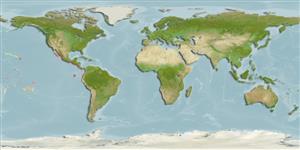Environment: milieu / climate zone / depth range / distribution range
Ecology
Marine; reef-associated; non-migratory; depth range 4 - 30 m (Ref. 5227). Tropical; 28°N -
Eastern Pacific: Gulf of California to Peru, including the Galapagos Islands.
Size / Weight / Age
Maturity: Lm ? range ? - ? cm
Max length : 35.6 cm TL male/unsexed; (Ref. 5592); common length : 15.0 cm TL male/unsexed; (Ref. 55763)
Diurnal grazer on sessile invertebrates and algae but specializes to a larger extent on sponges. Also feeds on plankton. Reproduction occurs in late summer. Females are more territorial and form pair bonds with the males. Oviparous (Ref. 240), monogamous (Ref. 52884). Sometimes forms mixed aggregations with Pomacanthus zonipectus (Ref. 9333). Cleaning behavior has been observed in juveniles.
Life cycle and mating behavior
Maturity | Reproduction | Spawning | Eggs | Fecundity | Larvae
Spawn daily throughout the lunar cycle (Ref. 240). Protogyny has been proposed for this species awaiting confirmation (Ref. 103751). Monogamous mating is observed as both facultative and social (Ref. 52884).
Thomson, D.A., 1987. Reef fishes of the Sea of Cortez. The rocky-shore fishes of the Gulf of California. The University of Arizona Press, Tucson. 302 p. (Ref. 5592)
IUCN Red List Status (Ref. 130435: Version 2024-1)
Threat to humans
Harmless
Human uses
Fisheries: commercial; aquarium: commercial
Tools
Special reports
Download XML
Internet sources
Estimates based on models
Preferred temperature (Ref.
123201): 22.9 - 29.1, mean 27 °C (based on 211 cells).
Phylogenetic diversity index (Ref.
82804): PD
50 = 0.5078 [Uniqueness, from 0.5 = low to 2.0 = high].
Bayesian length-weight: a=0.02951 (0.01493 - 0.05834), b=2.92 (2.75 - 3.09), in cm total length, based on LWR estimates for this species & (Sub)family-body (Ref.
93245).
Trophic level (Ref.
69278): 2.6 ±0.33 se; based on food items.
Generation time: 8.7 ( na - na) years. Estimated as median ln(3)/K based on 1
growth studies.
Resilience (Ref.
120179): Low, minimum population doubling time 4.5 - 14 years (Preliminary K or Fecundity.).
Fishing Vulnerability (Ref.
59153): Moderate to high vulnerability (54 of 100).
Nutrients (Ref.
124155): Calcium = 44.8 [22.2, 76.4] mg/100g; Iron = 0.524 [0.313, 0.874] mg/100g; Protein = 18.2 [16.9, 19.4] %; Omega3 = 0.0876 [, ] g/100g; Selenium = 30.6 [16.1, 58.5] μg/100g; VitaminA = 65 [15, 248] μg/100g; Zinc = 1.4 [1.0, 2.0] mg/100g (wet weight);
